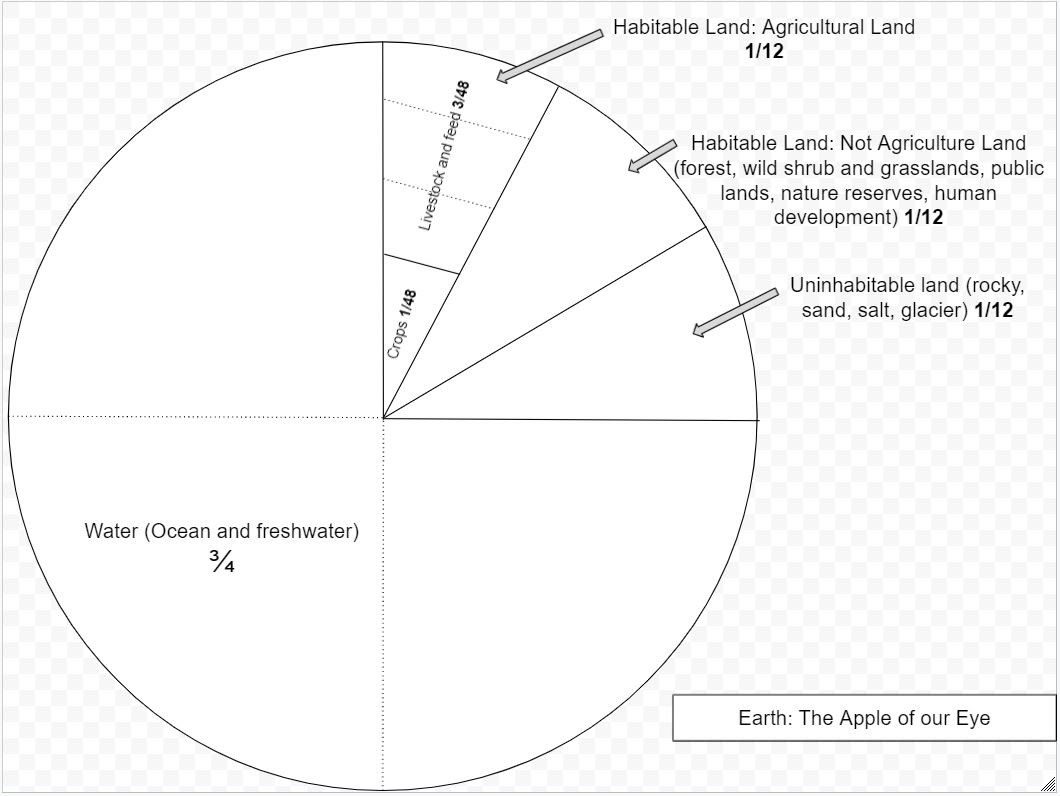The Population Education team is thrilled to announce we have made a significant update to one of our most popular lesson plans, Earth: The Apple of Our Eye. This blog provides an overview of all updates made to the free-to-download ‘Earth as an apple’ middle grades lesson plan and high school grades lesson plan, and explanations for why we made these updates.

Overall Content Updates
Shifting Focus from Arable Land to Agricultural Land
In the original Earth: The Apple of Our Eye lesson, we focused on arable land, defined by UN Food and Agriculture Organization (FAO) as land under temporary crops, meadows and pastures. After reviewing the FAO’s most updated definitions, we determined arable land does not encompass all the land we are currently using to grow our food, which was the intended focus of the lesson plan. Therefore, we shifted the focus of the lesson to the all-encompassing term for land used to grow food: agricultural land. The FAO defines agricultural land as arable land, permanent crops, and permanent pastures.
Framing Agricultural Land as a Resource to be Sustainably Managed
In the original lesson, we reference arable land as a finite resource. But what we see in the real world is that other forms of habitable land, like forest land, can be converted to arable land through practices such as deforestation. So arable land is not technically finite. However, this is not a sustainable trend on a large-scale. So with the shifted focus from arable land to agricultural land in the lesson plan, we reference agricultural land as a resource that needs to be sustainably managed. If not, we will continue to see an expansion of new agricultural land onto other forms of habitable land that are home to wildlife, such as forests, and shrub and wild grasslands.
Overall Procedure Updates
We decided to create a version of the “Earth as an apple” lesson specific for middle grades, and another for high school grades, in order to utilize the most fitting skills and useful content for at-grade standards alignment. The apple cutting portion in Part 1 is similar in both versions, though the discussion questions vary. Both versions have a new Part 2 that focuses on soil health, but the procedures are different, and we’ll explain both here.
Part 1: Cutting the Apple to Find Agricultural Land
In the original Earth: Apple of our Eye lesson plan, an apple is sliced into pieces to model the amount of total arable land available on the Earth’s surface. In this new edition, we are still slicing an apple into pieces, but now it is to model the current amount of agricultural land on Earth. The specific apple slices in the new edition are as follows:
- Water is represented by 3/4 of the apple and land is 1/4 of the apple – that hasn’t changed!
- Then we cut the 1/4 piece representing land into thirds. One of these thirds (or 1/12 of the apple) represents inhospitable land. This land includes the polar regions, deserts, salt flats, and high or rocky mountains.
- The remaining two-thirds of the land (2/12 of the apple) represent habitable land. This is land where people can live and we could grow food. But we do not use all of this land for agriculture.
- We then divide the habitable land in half: one piece (1/12 of the apple, 1/3 of the land, 1/2 of the habitable land) represents non-agricultural land, such as forests, wild shrub and grasslands, developed areas, etc; the other piece (1/12 of the apple, 1/3 of the land, 1/2 of the habitable land) represents agricultural land.
- Finally, we slice the apple representing agricultural land into four pieces. Three of the pieces (3/4 of agricultural land, 3/48 of the apple) represent land used for livestock and feed. The remaining one piece (1/4 agricultural land, 1/48 of the apple) represents land where we grow crops for direct human consumption.
After the apple slicing narrative, students engage in discussion questions rooted in inquiry-based learning, ranging from considering how an increasing human population might impact the sizes of various apple segments, to why so much more agricultural land is dedicated to producing livestock than producing crops directly consumed by humans.
Part 2: Reading Comprehension and Research on Soil Health
In the middle school lesson plan, Part 2 asks students to read and annotate, “Do We Treat Our Soil like Dirt?,” a National Geographic article with an adjustable text-level, which highlights threats to soil health and potential solutions. Then, students partner in small groups to conduct research and create a presentation that includes an explanation of one of the many threats to soil, a solution to respond to that threat, and an explanation of why it is important to protect soil.
The high school level lesson plan’s Part 2 also has students read the Nat Geo article as a primer to soil health issues. But then students investigate a soil topic and answer guiding questions from a provided Soil Conservation Assignment Card. This investigation prepares them for the upcoming “Ask the Experts” Soil Fair, where each group sets up a station around the classroom with a visual presentation on their topic and students take turns serving as the “expert” – being on hand to answer questions about their soil topic from peers.
Both of the new editions of Earth: The Apple of Our Eye wrap up with a reflection activity as the assessment and offer follow-up activities to extend and localize learning.
Population Growth and Soil Health
Through the new procedure in both versions, students will draw connections between population growth, agricultural land, and human-caused threats to agricultural land and soil health. Through dynamic research, synthesizing new and past knowledge, and creating peer presentations, students take learning into their own hands and are able to draw important connections for themselves.



